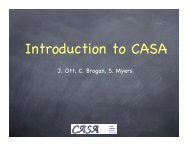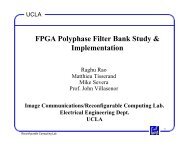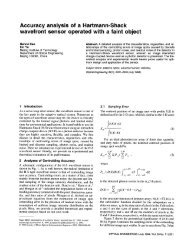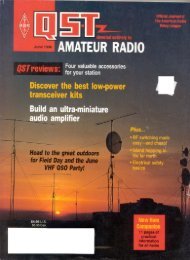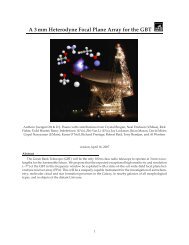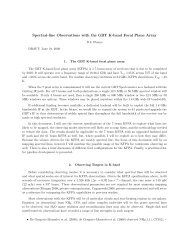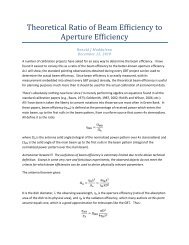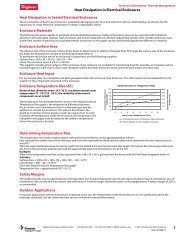The ALMA Spectral Line Catalog: Splatalogue
The ALMA Spectral Line Catalog: Splatalogue
The ALMA Spectral Line Catalog: Splatalogue
You also want an ePaper? Increase the reach of your titles
YUMPU automatically turns print PDFs into web optimized ePapers that Google loves.
<strong>The</strong> <strong>ALMA</strong> <strong>Spectral</strong> <strong>Line</strong> <strong>Catalog</strong>:<br />
<strong>Splatalogue</strong><br />
NAASC-00.00.00.10-002-A-PLA<br />
Version: B.2<br />
Status: FINAL<br />
2010-09-27<br />
Prepared By: Organization Date<br />
Anthony J. Remijan<br />
Mark Lacy<br />
NRAO<br />
NRAO<br />
Approved by: Organization Date<br />
Anthony J. Remijan<br />
NRAO<br />
Released by IPT Lead(s): Organization Date<br />
2010-09-27
<strong>The</strong> <strong>ALMA</strong> <strong>Spectral</strong> <strong>Line</strong><br />
<strong>Catalog</strong>: <strong>Splatalogue</strong><br />
Introduction<br />
Doc # : NAASC-00.00.00.10-002-A-PLA<br />
Date: 2010-09-27<br />
Status: DRAFT<br />
Page: 2 of 15<br />
<strong>Splatalogue</strong> is a spectral line database developed at NRAO. It is a compilation of data<br />
from several external lists and databases, and also includes a front-end webpage for direct<br />
queries. <strong>Splatalogue</strong> is used as a reference source for spectral line data by several <strong>ALMA</strong><br />
software tools, including the Observing Tool (OT) and CASA. In addition, it is likely to<br />
be used for the <strong>ALMA</strong> Science Archive (ASA) spectral line searches. This memo<br />
describes the process whereby data are included in <strong>Splatalogue</strong>, reconciliation of different<br />
database formats and the assignment of “NRAO recommended frequencies” where<br />
different values are found in different databases, and presents the plan for management<br />
and development of the database and front end.<br />
In this memo, we address the following:<br />
1. Motivation and Description of the Current Database<br />
2. Procedure for Referencing External Databases<br />
2.1. Procedure for Accepting New Data into <strong>Splatalogue</strong><br />
3. Description of Currently Included Databases<br />
4. Procedure for Assigning NRAO Recommended Rest Frequencies<br />
5. Quantum number Format and Reconciliation scheme<br />
6. Version control scheme<br />
7. Release schedule<br />
8. Regression testing<br />
9. Management and Oversight (<strong>Spectral</strong> <strong>Line</strong> Working groups NRAO/International)<br />
10. Proposed criterion for offline subsets for OT and CASA and how they will be<br />
maintained and updated<br />
11. Virtual Astronomical Observatory (VAO) Interface<br />
12. Vision for Future <strong>Splatalogue</strong> Interaction with other <strong>Spectral</strong> <strong>Line</strong> Databases<br />
1. Motivation and Description of the Current Database<br />
<strong>The</strong> next generation of powerful radio and millimeter/submillimeter observatories (e.g.<br />
EVLA, <strong>ALMA</strong> & Herschel) require extensive resources to help identify spectral line<br />
transitions. <strong>The</strong> <strong>ALMA</strong> <strong>Spectral</strong> <strong>Line</strong> <strong>Catalog</strong> (<strong>Splatalogue</strong>) is an attempt to collate,<br />
rationalize and extend existing spectroscopic resources for use by the astronomical<br />
community. Until the concept of <strong>Splatalogue</strong>, the astronomical community referenced<br />
primarily three publically available online catalogs. <strong>The</strong> Jet Propulsion Laboratory (JPL)<br />
database, the Cologne Database of Molecular Spectroscopy (CDMS) and the<br />
Lovas/National Institute of Standards and Technology (NIST) database. Together, these<br />
provide an enormous amount of data – collecting the data in all three online databases<br />
generates over 3.5 million transition data entries across almost 700 molecular species.
<strong>The</strong> <strong>ALMA</strong> <strong>Spectral</strong> <strong>Line</strong><br />
<strong>Catalog</strong>: <strong>Splatalogue</strong><br />
Doc # : NAASC-00.00.00.10-002-A-PLA<br />
Date: 2010-09-27<br />
Status: DRAFT<br />
Page: 3 of 15<br />
Currently, <strong>Splatalogue</strong> is a transition-resolved (see section 5.) compilation of the JPL<br />
(http://spec.jpl.nasa.gov/), CDMS (http://www.cdms.de/), the Lovas/NIST List<br />
(http://physics.nist.gov/cgi-bin/micro/table5/start.pl), Frank Lovas' own <strong>Spectral</strong> <strong>Line</strong><br />
Atlas of Interstellar Molecules (SLAIM), data from the Toyama Microwave Atlas for<br />
spectroscopists and astronomers (http://www.sci.u-toyama.ac.jp/phys/4ken/atlas/), new<br />
methanol data provided by Li-Hong Xu from <strong>The</strong> University of New Brunswick, Canada<br />
(which can be found under the "LISA <strong>Line</strong>s" <strong>Line</strong> List selection), experimental<br />
laboratory data from Frank De Lucia's lab at <strong>The</strong> Ohio State University, H, He and C<br />
recombination lines, and selected atomic transition. Currently, <strong>Splatalogue</strong> contains over<br />
5.8 million lines in 1038 individual entries<br />
2. Procedure for Referencing External Databases<br />
<strong>The</strong> <strong>Splatalogue</strong> effort would not be possible without the efforts of laboratories all over<br />
the world. Data from the publically available catalogs such as JPL and CDMS are<br />
updated in <strong>Splatalogue</strong> as new species or updates to existing species are reported by these<br />
existing online catalogs. In the last column of any search with <strong>Splatalogue</strong>, is displayed<br />
the "<strong>Line</strong>List" where the data originated. For these data, off the main <strong>Splatalogue</strong> home<br />
page you will notice the following references to each lab group that has provided the<br />
data:<br />
• CDMS: H. S. P. Müller, F. Schlöder, J. Stutzki, and G. Winnewisser, J. Mol.<br />
Struct. 742, 215-227 (2005)<br />
• JPL: H. M. Pickett, R. L. Poynter, E. A. Cohen, M. L. Delitsky, J. C. Pearson, and<br />
H. S. P. Muller, "Submillimeter, Millimeter, and Microwave <strong>Spectral</strong> <strong>Line</strong><br />
<strong>Catalog</strong>," J. Quant. Spectrosc. & Rad. Transfer 60, 883-890 (1998).<br />
• Lovas/NIST: F.J. Lovas and R.A. Dragoset (2004), NIST Recommended Rest<br />
Frequencies for Observed Interstellar Molecular Microwave Transitions -<br />
2002 Revision, (version 2.0.1). [Online] Available: http://physics.nist.gov/restfreq<br />
[2009, February 4]. National Institute of Standards and Technology, Gaithersburg,<br />
MD. Optional addition: Also published as J. Phys. Chem. Ref. Data 33(1), 177-<br />
355 (2004).<br />
• ToyaMA: Toyama Microwave Atlas for spectroscopists and astronomers is<br />
available at: http://www.sci.u-toyama.ac.jp/phys/4ken/atlas/ and thanks goes out<br />
to Kaori Kobayashi (University of Toyama) and her collaborators for making<br />
these data available to the astronomical community.<br />
• LISA <strong>Line</strong>s: Currently, this line list contains new methanol data provided by Li-<br />
Hong Xu from <strong>The</strong> University of New Brunswick, Canada.
<strong>The</strong> <strong>ALMA</strong> <strong>Spectral</strong> <strong>Line</strong><br />
<strong>Catalog</strong>: <strong>Splatalogue</strong><br />
Doc # : NAASC-00.00.00.10-002-A-PLA<br />
Date: 2010-09-27<br />
Status: DRAFT<br />
Page: 4 of 15<br />
• OSU: Experimental Intensity Calibrated Spectra as a Function of Temperature.<br />
Thanks goes out to Frank De Lucia and his collaborators at <strong>The</strong> Ohio State<br />
University for making their data publically available to the astronomical<br />
community.<br />
• SLAIM: In referencing SLAIM, use the following "All spectral line data were<br />
taken from the <strong>Spectral</strong> <strong>Line</strong> Atlas of Interstellar Molecules (SLAIM) (Available<br />
at http://www.splatalogue.net). (F. J. Lovas, private communication, Remijan et<br />
al. 2007)"<br />
Finally, when possible, an individual transition may be referenced. In the left hand<br />
frame, under the Miscellaneous tab, you will be able to choose “Lovas Lab Ref” and<br />
“Lovas Ast Ref” as part of the display of transitions from SLAIM and the Lovas/NIST<br />
list. When this is selected, a reference for each transition listed in those databases is<br />
available through a small “pop-up” window as illustrated below. <strong>Splatalogue</strong> is very<br />
aware of the need to properly reference data so we make every effort to accurately report<br />
where the data contained in <strong>Splatalogue</strong> comes from.<br />
2.1 Procedure for accepting new data into <strong>Splatalogue</strong><br />
Data for inclusion into <strong>Splatalogue</strong> should be are sent via email or other personal<br />
correspondence to the authors of <strong>Splatalogue</strong> at splatalogue@nrao.edu. At any time,<br />
questions, comments, or criticism can be sent to the authors of <strong>Splatalogue</strong>. When we<br />
receive the data from the laboratories, we ask for a complete description of the data they<br />
are sending including units of transition frequency, line strength, and energy level. In
<strong>The</strong> <strong>ALMA</strong> <strong>Spectral</strong> <strong>Line</strong><br />
<strong>Catalog</strong>: <strong>Splatalogue</strong><br />
Doc # : NAASC-00.00.00.10-002-A-PLA<br />
Date: 2010-09-27<br />
Status: DRAFT<br />
Page: 5 of 15<br />
addition, we request comments on the line fitting parameters including upper limits to the<br />
total angular momentum (J) or the projection of J onto the various axes of symmetry (Ka<br />
and Kc). Finally, we ask for an appropriate reference to the data if it is available in the<br />
literature, a laboratory identifying name (e.g. SLAIM) and any other comments on the<br />
transitions reported. <strong>The</strong>se data are then included into the <strong>Splatalogue</strong> database and made<br />
available to the lab group via the online web interface. In addition, <strong>Splatalogue</strong> reports<br />
where the data presented came from, both off the main page and each transition is labeled<br />
with a reference after a search is conducted.<br />
Many labs have already either provided data or agreed, in principle, to providing<br />
laboratory data to <strong>Splatalogue</strong>. If a formal agreement is necessary between <strong>Splatalogue</strong><br />
and the laboratories, such an agreement can be generated and signed by the constituent<br />
members.<br />
3. Description of Currently Included Databases<br />
<strong>Splatalogue</strong> currently contains seven databases of molecular line data. <strong>The</strong>se molecular<br />
data populate various fields and metadata as made available from each lab group. <strong>The</strong><br />
table below summarizes the type of data that are available in each catalog. In addition,<br />
we give a more complete description where we describe the relevant spectroscopic data<br />
available in each catalog.<br />
Molecular<br />
Name<br />
and<br />
Formula<br />
Predicted Measured Quantum<br />
Frequency Frequency Numbers<br />
Transition<br />
State<br />
Energy<br />
Levels<br />
Upper State Transition<br />
Degeneracy <strong>Line</strong><br />
Strength<br />
Species<br />
Metadata<br />
Table<br />
JPL X X X X X X X X<br />
CDMS X X X X X X X X<br />
Lovas/NIST X X X X X<br />
SLAIM X X X X X X X X<br />
ToyaMA X X X X X X X<br />
OSU X X X X X<br />
LISA <strong>Line</strong>s X X X X X X X X
<strong>The</strong> <strong>ALMA</strong> <strong>Spectral</strong> <strong>Line</strong><br />
<strong>Catalog</strong>: <strong>Splatalogue</strong><br />
Doc # : NAASC-00.00.00.10-002-A-PLA<br />
Date: 2010-09-27<br />
Status: DRAFT<br />
Page: 6 of 15<br />
JPL - Data from JPL contain:<br />
• Molecular Name and Formula<br />
• Predicted transition frequency and error OR laboratory measured frequency and<br />
error (see section 4.)<br />
• Transition quantum numbers (QNs) in Pickett format AND resolved (QNs) (see<br />
section 5.)<br />
• Transition upper state degeneracy, upper state energy (cm -1 and K) and lower<br />
state energy (cm -1 and K)<br />
• Transition line strength as measured at 300K in the lab (CDMS/JPL Intensity in<br />
<strong>Splatalogue</strong> display), Sijµ 2 (D 2 ), Aij (s) and Sij (when possible)<br />
• Species metadata tables that contain: dipole moments, partition functions (range<br />
in temperature from 9.275 to 300K), molecular A, B and C constants (where<br />
applicable) and references to previous lab work or predictions.<br />
CDMS – Data from CDMS contain:<br />
• Molecular Name and Formula<br />
• Predicted transition frequency and error OR laboratory measured frequency and<br />
error (see section 4.)<br />
• Transition quantum numbers (QNs) in Pickett format AND resolved (QNs) (see<br />
section 5.)<br />
• Transition upper state degeneracy, upper state energy (cm -1 and K) and lower<br />
state energy (cm -1 and K)<br />
• Transition line strength as measured at 300K in the lab (CDMS/JPL Intensity in<br />
<strong>Splatalogue</strong> display), Sijµ 2 (D 2 ), Aij (s) and Sij (when possible)<br />
• Species metadata tables that contain: dipole moments, partition functions (range<br />
in temperature from 9.275 to 300K), molecular A, B and C constants (where<br />
applicable) and references to previous lab work or predictions.<br />
SLAIM – Data from SLAIM contain:<br />
• Molecular Name and Formula<br />
• Predicted transition frequency and error AND laboratory measured frequency and<br />
error (when reported)<br />
• Transition quantum numbers (QNs) in AND resolved (QNs)<br />
• Transition upper state degeneracy, upper state energy (cm -1 and K) and lower<br />
state energy (cm -1 and K)<br />
• Transition line strength as measured Sijµ 2 (D 2 ), Aij (s) and Sij (when possible)<br />
• Relative strength of the hyperfine components of molecules with measured<br />
hyperfine structure.<br />
• Species metadata tables that contain: dipole moments, molecular A, B and C<br />
constants (where applicable) and references to previous lab work or predictions.<br />
Lovas/NIST – Data from Lovas/NIST contain:<br />
• Molecular Name and Formula
<strong>The</strong> <strong>ALMA</strong> <strong>Spectral</strong> <strong>Line</strong><br />
<strong>Catalog</strong>: <strong>Splatalogue</strong><br />
Doc # : NAASC-00.00.00.10-002-A-PLA<br />
Date: 2010-09-27<br />
Status: DRAFT<br />
Page: 7 of 15<br />
• Predicted transition frequency<br />
• Transition quantum numbers (QNs) in AND resolved (QNs)<br />
• Astronomical transition line strength reported by the detection paper (when<br />
possible)<br />
• Species metadata tables that contain references to the astronomical detection<br />
paper and previous lab work or predictions.<br />
ToyaMA – Data from ToyaMA contain:<br />
• Molecular Name and Formula<br />
• Measured transition frequency<br />
• Transition quantum numbers (QNs) in AND resolved (QNs)<br />
• Transition upper state degeneracy, upper state energy (cm -1 and K) and lower<br />
state energy (cm -1 and K) (when possible)<br />
• Transition line strength as measured Sijµ 2 (D 2 ), Aij (s) and Sij (when possible)<br />
• Species metadata tables tables that contain: dipole moments, molecular A, B and<br />
C constants (where applicable) and references to previous lab work or predictions.<br />
LISA <strong>Line</strong>s – Data from LISA <strong>Line</strong>s contain:<br />
• Molecular Name and Formula<br />
• Predicted transition frequency and error AND laboratory measured frequency and<br />
error (when reported)<br />
• Transition quantum numbers (QNs) in AND resolved (QNs)<br />
• Transition upper state degeneracy, upper state energy (cm -1 and K) and lower<br />
state energy (cm -1 and K)<br />
• Transition line strength as measured Sijµ 2 (D 2 ), Aij (s) and Sij (when possible)<br />
• Species metadata tables that contain: dipole moments, molecular A, B and C<br />
constants (where applicable) and references to previous lab work or predictions.<br />
OSU – Data from OSU contain:<br />
• Molecular Name and Formula<br />
• Measured transition frequency<br />
• Transition upper state energy (cm -1 and K) and lower state energy (cm -1 and K)<br />
• Transition line strength as measured Sijµ 2 (D 2 ), Aij (s) and Sij (when possible)<br />
• Species tables that contain the point-by-point laboratory measurement of the<br />
experimental data. <strong>The</strong>se are available through the OSU lab website and linked<br />
off the main <strong>Splatalogue</strong> homepage along with an explanation of the methodology<br />
of the experiment.<br />
4. Procedure for Assigning NRAO Recommended Rest Frequencies
<strong>The</strong> <strong>ALMA</strong> <strong>Spectral</strong> <strong>Line</strong><br />
<strong>Catalog</strong>: <strong>Splatalogue</strong><br />
Doc # : NAASC-00.00.00.10-002-A-PLA<br />
Date: 2010-09-27<br />
Status: DRAFT<br />
Page: 8 of 15<br />
<strong>Splatalogue</strong> provides an additional service over and above a simple compilation of<br />
available databases by providing an “NRAO recommended frequency”. This is selected<br />
through a careful consideration of the properties of the different databases. In general,<br />
<strong>Splatalogue</strong> displays two possible frequencies with each species: "Freq" and "Meas Freq"<br />
(see Figure 1). In the cases of JPL, CDMS, SLAIM, and the LISA line lists, "Freq" is the<br />
theoretically predicted frequency of the molecule and is calculated based on the<br />
experimentally determined molecular constants. <strong>The</strong>se constants are found in the<br />
literature and reference is given to the paper(s) from which the values are obtained. <strong>The</strong><br />
"Meas Freq" values are the laboratory measurements that have been published in the<br />
literature. Again, reference is given to the paper(s) from which the values are obtained.<br />
<strong>The</strong> reference list and additional information about the molecule can be found by clicking<br />
on the chemical formula.<br />
Figure 1.<br />
<strong>The</strong> laboratory measured values are given if available (such as with the JPL and CDMS<br />
catalogs). Otherwise, the theoretical/calculated values are posted, but not both. In some<br />
cases, such as with SLAIM and the LISA lines, both values are posted. <strong>The</strong> predicted<br />
frequency is given and the measured frequency is posted where available. In cases where<br />
both frequencies are listed, the user will notice slight differences in the laboratory value<br />
and the theoretical/predicted value. It should be noted that for molecules with a well<br />
determined Hamiltonian the calculated frequencies are usually considered more accurate<br />
than the experimental laboratory measurements. For more information about how the<br />
theoretical/calculated frequencies were obtained, users should refer back to the original<br />
referenced catalog website. Finally, the data provided by Frank De Lucia's laboratory at<br />
<strong>The</strong> Ohio State University, gives ONLY measured frequencies as measured by his<br />
FASST technique. Further information about the data from <strong>The</strong> Ohio State University<br />
can be found on the OSU <strong>Splatalogue</strong> information page<br />
(http://www.cv.nrao.edu/php/splat/OSU_Splat.html).
<strong>The</strong> <strong>ALMA</strong> <strong>Spectral</strong> <strong>Line</strong><br />
<strong>Catalog</strong>: <strong>Splatalogue</strong><br />
Doc # : NAASC-00.00.00.10-002-A-PLA<br />
Date: 2010-09-27<br />
Status: DRAFT<br />
Page: 9 of 15<br />
<strong>The</strong> LOVAS line list only displays frequencies that have previously observed in space.<br />
<strong>The</strong>se are displayed under the "Freq" column. For information about the origin of the<br />
observed transitions users should visit: http://www.nist.gov/physlab/data/micro/index.cfm<br />
and http://physics.nist.gov/PhysRefData/Micro/Html/sec2.html.<br />
Often, many different line lists contain the same transition of a particular molecular<br />
species. <strong>The</strong> NRAO has assigned a "flag" for the recommended rest frequency for all<br />
known interstellar molecules. This flag can be turned on under the "Miscellaneous"<br />
section of the left sidebar. You will see a checkbox that says, "Display NRAO<br />
Recommended Frequencies". Select that option and search. A "splat" ( ) will appear<br />
next to the transition frequency that NRAO recommends (see figure 2). In the case where<br />
there is a measured and observed frequency for a given transition, refer to the paragraph<br />
above but in general, the calculated frequency is often the best one to use.<br />
Figure 2.<br />
<strong>The</strong> decision of which line list and which frequency should be recommended is as<br />
follows:<br />
• ONLY known interstellar molecules have been given a recommended rest<br />
frequency. This is following the "Lovas Recommended Rest Frequencies" lists<br />
published in the Journal of Molecular Spectroscopy Reference Data.<br />
• <strong>The</strong> most recent catalog entry is typically used.<br />
• <strong>The</strong> choice is subject to consideration of how close the measured frequency is to<br />
the predicted one. If the prediction is "too far" away from the last measured<br />
frequency, the frequency is not included. <strong>The</strong> definition of "too far" was molecule<br />
dependent and the users should consult the original references for the laboratory<br />
observations.<br />
• In general, frequencies with errors larger than 10's of MHz (of course, depending<br />
on the actual rest frequency of the transition) were not recommended. Again, the
<strong>The</strong> <strong>ALMA</strong> <strong>Spectral</strong> <strong>Line</strong><br />
<strong>Catalog</strong>: <strong>Splatalogue</strong><br />
Doc # : NAASC-00.00.00.10-002-A-PLA<br />
Date: 2010-09-27<br />
Status: DRAFT<br />
Page: 10 of 15<br />
users should consult the original laboratory references for the errors involved with<br />
the experimental setup.<br />
5. Quantum number Format and Reconciliation scheme<br />
<strong>The</strong> Table available at http://www.cv.nrao.edu/php/splat/QuantumCode.html provides<br />
examples of how the quantum numbers were resolved based on the "rules" that have been<br />
defined by JPL and CDMS. In general, while many of the examples provided describe<br />
how the quantum numbers were translated, many of the molecular species contained in<br />
this database and others do not follow any exact rule for interpreting the transition. If<br />
there are questions on the translation, the user should refer back to the original reference<br />
of the molecule. All the references for each species contained in <strong>Splatalogue</strong> can be<br />
found by clicking on the molecular species of interest in the display list. See figure<br />
below:<br />
6.
<strong>The</strong> <strong>ALMA</strong> <strong>Spectral</strong> <strong>Line</strong><br />
<strong>Catalog</strong>: <strong>Splatalogue</strong><br />
Version control scheme<br />
Doc # : NAASC-00.00.00.10-002-A-PLA<br />
Date: 2010-09-27<br />
Status: DRAFT<br />
Page: 11 of 15<br />
Many of the online databases update a particular molecular species when either new<br />
laboratory measurements become available or a better fit to the existing data is possible.<br />
This is recorded in a species id version number. However, access to the previous version<br />
is often problematic because the old data are removed from the server at the time of the<br />
update. This presents a problem to both new users of the catalog as previously reported<br />
transitions may now be lost from the database as well as those following up reported<br />
transitions from the literature.<br />
In <strong>Splatalogue</strong>, data are not deleted when an update is made available. Rather the<br />
updated data are flagged as a new version in the database. <strong>The</strong>refore, a user of<br />
<strong>Splatalogue</strong> will be able to revert back to a previous version of a molecular species and<br />
directly compare the versions. As always, we will make a recommendation on which<br />
transition frequencies to use but the user will be able to access all the available data as<br />
they see fit.<br />
<strong>The</strong> interface will be subject to version control, with each release undergoing a regression<br />
test prior to being made publicly available.<br />
7. Release schedule<br />
<strong>The</strong> data in <strong>Splatalogue</strong> and the other online databases will constantly be changing as a<br />
result of new fits from existing data or new experimental data become available. As<br />
such, it is imperative that <strong>Splatalogue</strong> have a release schedule that is current enough so<br />
the user is confident that they are receiving the most up to date data available. Over the<br />
past several years, the rate at which major updates are added to the existing online<br />
databases is approximately quarterly. That is, new molecular species or updated fits for<br />
an existing species appear every 3-4 months on these databases. In the literature, new fits<br />
to existing molecules occur once every 2-5 years (this is very molecule dependent<br />
however.)<br />
Given the rate at which the data are coming from the laboratories, we anticipate an annual<br />
release and update of the database to account for any edits, changes or corrections that<br />
may take place in one of these online sources of data. In addition, an annual update to the<br />
database after our colleagues that will only use <strong>Splatalogue</strong> to disseminate their data have<br />
presented laboratory data in the literature is more than adequate given the rate at which<br />
these data appear in the literature. <strong>The</strong> OT and CASA offline databases will also be<br />
updated on this schedule.<br />
Finally, additions, subtractions or edits to the <strong>Splatalogue</strong> homepage have been taking<br />
place on an “as needed” basis given individual user requests. This format will change<br />
also to a yearly release. Individual updates or changes that are requested by the user
<strong>The</strong> <strong>ALMA</strong> <strong>Spectral</strong> <strong>Line</strong><br />
<strong>Catalog</strong>: <strong>Splatalogue</strong><br />
Doc # : NAASC-00.00.00.10-002-A-PLA<br />
Date: 2010-09-27<br />
Status: DRAFT<br />
Page: 12 of 15<br />
community will be compiled via a community forum. This “<strong>Splatalogue</strong> forum” will also<br />
contain many of the “tools and tips” provided by the community on how to best use<br />
<strong>Splatalogue</strong> for their individual science goals as well as a FAQ page where uses can get<br />
answers to the most common questions. In addition, a <strong>Splatalogue</strong> helpdesk and<br />
knowledgebase will be available through the NRAO and <strong>ALMA</strong> User Portals. This<br />
system will allow users to submit questions and problems they find while using the<br />
<strong>Splatalogue</strong> homepage or SLAP interface (section 11 below) as well as request new<br />
additions to <strong>Splatalogue</strong>. <strong>The</strong>se requests and bug reports will be compiled and then<br />
incorporated into the annual release.<br />
For minor changes and bugs affecting performance or search capabilities, the <strong>Splatalogue</strong><br />
homepage will be updated with “patches” over the course of a year depending on the<br />
severity of the problem found and the time needed for repair. If necessary, in the most<br />
extreme cases, functionality may be removed if the repair will take more than 72 hours to<br />
diagnose and complete. However, we anticipate this happening only in rare cases.<br />
8. Regression testing<br />
Before each release or each patch is submitted online to the main <strong>Splatalogue</strong> homepage<br />
or changes are made to the SLAP interface, they will be tested by the <strong>Splatalogue</strong><br />
manager and other members of the NAASC Data Services Group, User Support Group<br />
and the NRAO spectral line management group. <strong>The</strong>se tests will take place off another<br />
server so as not to interrupt the normal usage off the www.splatalogue.net homepage.<br />
Once the groups have decided the appropriate changes have been made and that all the<br />
functionality works properly, that release will then be posted off of the main <strong>Splatalogue</strong><br />
homepage for general use by the community.<br />
Once changes are made, they will be logged and presented to the community off the<br />
<strong>Splatalogue</strong> “What’s New (Updates and Announcements)” page. Again, because of the<br />
versioning capabilities of <strong>Splatalogue</strong>, users will be able to view the older sets of data.<br />
However, users will not be able to revert back to an older version of the webpage or<br />
SLAP interface. <strong>The</strong> only way this will occur is if the updated version is found to have<br />
reduced functionality or options that are required/requested by the community. All<br />
versions of the <strong>Splatalogue</strong> homepage are saved and can be reverted at any time but only<br />
in the most extreme of circumstances.<br />
9. Management and Oversight (<strong>Spectral</strong> <strong>Line</strong> Working groups<br />
NRAO/International)<br />
<strong>The</strong> purpose of this memo is to propose that <strong>Splatalogue</strong> become the official <strong>ALMA</strong><br />
spectral line database. As such, NRAO and the NAASC have already committed to the<br />
formation of the database and have appointed a <strong>Splatalogue</strong> task lead inside of the Data<br />
Services Group of the NAASC. Currently this lead is:
<strong>The</strong> <strong>ALMA</strong> <strong>Spectral</strong> <strong>Line</strong><br />
<strong>Catalog</strong>: <strong>Splatalogue</strong><br />
Doc # : NAASC-00.00.00.10-002-A-PLA<br />
Date: 2010-09-27<br />
Status: DRAFT<br />
Page: 13 of 15<br />
Anthony Remijan – Assistant Scientist (NRAO) / CSV Liaison (NAASC)<br />
It is anticipated that the task lead for <strong>Splatalogue</strong> rotate over time as responsibilities for<br />
an individual would change over time. However, the task lead should be at least a staff<br />
scientist with NRAO. Additional postdoc or scientist effort will also be supplied to help<br />
update and maintain the database.<br />
In order to facilitate community input and oversight into <strong>Splatalogue</strong>, the NAASC has<br />
formed an “internal" <strong>Spectral</strong> <strong>Line</strong> Management Group in Charlottesville, consisting of<br />
Anthony Remijan, Crystal Brogan, Harvey Liszt, Al Wootten and Mark Lacy (ex officio).<br />
This management group consists of members of the NAASC User Support Group and<br />
Data Services Group. <strong>The</strong> main purpose of this group is to comment on the current user<br />
interfaces to <strong>Splatalogue</strong>, suggest upgrades and enhancements to searches and exporting<br />
options and to provide insight on the offline versions of <strong>Splatalogue</strong> that will be used for<br />
<strong>ALMA</strong> user tools and applications. <strong>The</strong>y will also comment on the usefulness of the data<br />
contained in <strong>Splatalogue</strong> and suggest additions or subtractions. This management plan is<br />
described in NAASC Memo 2010-Sept-001 “<strong>Splatalogue</strong> Management Plan”.<br />
However, we plan to expand the oversight of the data content in <strong>Splatalogue</strong> to a wider<br />
international community effort who are contributing a bulk of the data to the database and<br />
the astronomical community. This International <strong>Spectral</strong> <strong>Line</strong> Steering Committee will<br />
have the opportunity to consult with the <strong>Splatalogue</strong> task lead and provide the valuable<br />
insight necessary to suggest recommended rest frequencies, provide new laboratory<br />
measurements or re-calculate fits on existing molecular line data to be used by the<br />
astronomical community.<br />
Many of the possible representatives have already contributed data to the <strong>Splatalogue</strong><br />
effort and conversations have already started on expanding the group membership as well<br />
as publishing a yearly microwave molecular spectroscopy review paper which would be<br />
analogous to the HITRAN efforts. <strong>The</strong> lead of the International Steering committee<br />
would be the <strong>Splatalogue</strong> task lead but the chair of the committee would rotate yearly.<br />
Currently, the international consortium is only in the planning stage but the internal<br />
spectral line management group has already been established.<br />
10. Proposed criterion for Offline subsets for OT and CASA and how they will be<br />
maintained and updated<br />
Both CASA and the <strong>ALMA</strong> OT have a very specific charge that they must be usable<br />
while “offline”. As such, any spectral line query that accesses <strong>Splatalogue</strong> must also be<br />
able to work while a user is not connected to the internet.
<strong>The</strong> <strong>ALMA</strong> <strong>Spectral</strong> <strong>Line</strong><br />
<strong>Catalog</strong>: <strong>Splatalogue</strong><br />
Doc # : NAASC-00.00.00.10-002-A-PLA<br />
Date: 2010-09-27<br />
Status: DRAFT<br />
Page: 14 of 15<br />
In consultation with OT representatives, it was clear they wanted a subset of the<br />
<strong>Splatalogue</strong> database that can be accessed offline that would contain no more than 30000<br />
individual entries.<br />
It was decided that the most useful catalog for the offline version of the OT was a<br />
“Lovas/NIST” type catalog that contained all of the detected astronomical transitions, all<br />
of the H, He and C recombination lines and all the atomic transitions. This was sent to<br />
the OT group in as a .csv file and was then incorporated into the OT. This list currently<br />
contains ~18000 line entries that can be searched on in the offline version of the OT.<br />
CASA wanted a much larger subset of lines to carry along for the offline version. This<br />
was deemed necessary because it may be that CASA would not access the online version<br />
of <strong>Splatalogue</strong>.<br />
For details on what part of the <strong>Splatalogue</strong> databases is used in CASA, see the following<br />
website:<br />
https://safe.nrao.edu/wiki/bin/view/<strong>ALMA</strong>/CASA_Offline_Splat_list<br />
When substantial changes are made to the Lovas/NIST or radio recombination line lists,<br />
where “substantial” is to be defined by the <strong>Spectral</strong> <strong>Line</strong> Management Group, a new<br />
version of the offline data subset will be sent to the <strong>ALMA</strong> OT working groups.<br />
In addition, the <strong>Splatalogue</strong> homepage has been built so that a user will be able to export<br />
a subset of the data they want for import into CASA. As such, the CASA working group<br />
will be able to update their offline version as they see fit simply by exporting the requisite<br />
data from the <strong>Splatalogue</strong> homepage.<br />
Additional edits/additions to the <strong>Splatalogue</strong> homepage or to the data contained in<br />
<strong>Splatalogue</strong> that will affect the offline versions of the OT or CASA will again be posted<br />
off the “What’s New (Updates and Announcements)” page off the <strong>Splatalogue</strong> homepage<br />
as well as communicated directly to the project scientists of CASA and the OT by the<br />
<strong>Splatalogue</strong> task lead.<br />
11. Virtual Astronomical Observatory (VAO) Interface<br />
One of the deliverables from NRAO based on several meetings with the astronomical<br />
community is that <strong>Splatalogue</strong> should be Virtual Observatory (VO) compliant, as defined<br />
by the International Virtual Observatory (IVOA). As such, we have developed the<br />
appropriate interface following the standard VO spectral line access protocols to search<br />
the <strong>Splatalogue</strong> database given a frequency range and some optional filters , i.e. the VO<br />
standard SLAP protocol. For more information on the SLAP protocol, visit:
<strong>The</strong> <strong>ALMA</strong> <strong>Spectral</strong> <strong>Line</strong><br />
<strong>Catalog</strong>: <strong>Splatalogue</strong><br />
Doc # : NAASC-00.00.00.10-002-A-PLA<br />
Date: 2010-09-27<br />
Status: DRAFT<br />
Page: 15 of 15<br />
http://www.ivoa.net/Documents/SLAP/<br />
Ray Plante (NCSA and the University of Illinois) from the US Virtual Astronomical<br />
Observatory (VAO) has been working with the NRAO on this application to make it as<br />
general as possible so that any catalog that has the same database format as <strong>Splatalogue</strong><br />
can easily implement. We like to call it a "plug-and-play" VO application. This work has<br />
been finished and is publically available off a VAO (formerly NVO) site:<br />
http://trac.us-vo.org/project/nvo/wiki/SplataSLAP.<br />
<strong>The</strong>re you can obtain a tarball to configure and install the SLAP service for a <strong>Splatalogue</strong><br />
like database. <strong>The</strong> README.txt provides instructions for installation. Also, when one<br />
creates a compiled java program, a JAR (Java Archive) file is created that you can run at<br />
the command prompt. <strong>The</strong> WAR (web application archive) file is designed to be run off<br />
the web.<br />
Finally, Brian Kent (NRAO) has also generated some code accessing the database via the<br />
SLAP protocols with php and IDL. <strong>The</strong>y are available at:<br />
ftp://ftp.cv.nrao.edu/NRAO-staff/bkent/slap/<br />
<strong>The</strong>se are only examples of what can be done accessing a SLAP server. For the Green<br />
Bank Telescope, for example, who extensively use IDL as their data reduction software,<br />
they can implement what is written there to access line ids, etc.<br />
12. Vision for Future <strong>Splatalogue</strong> Interaction with other <strong>Spectral</strong> <strong>Line</strong> Databases<br />
Given the flexibility of both the database structure of <strong>Splatalogue</strong> and the SLAP<br />
interface, it may be possible in the future that telescope operations and tools will be able<br />
to query a general SLAP service and all catalogs that contain a <strong>Splatalogue</strong>-type database<br />
will be accessible to that tool.<br />
We have made that option available to the laboratory astrophysics community by<br />
providing both the SLAP interface and <strong>Splatalogue</strong> database structure. If these<br />
laboratories chose to use these structures, all <strong>ALMA</strong> tools will be able to access their<br />
database.<br />
In addition, it is anticipated that <strong>Splatalogue</strong> will become the microwave equivalent of the<br />
HITRAN database. Official <strong>ALMA</strong> support of the effort will go a long way as well as<br />
the establishment of the International Steering Committee. It is our plans to have such a<br />
steering committee established by the end of 2011.




